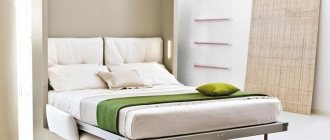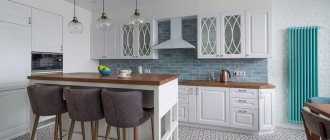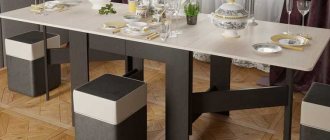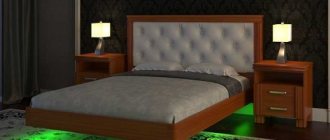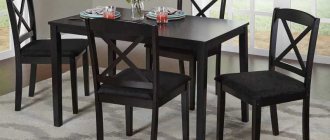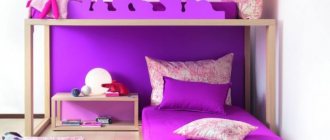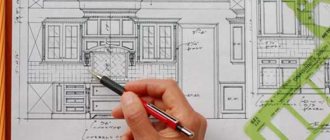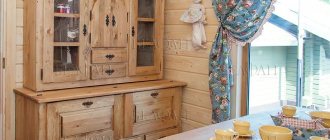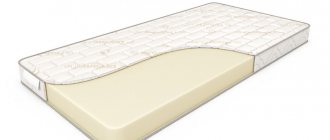29127
Laminated chipboard is one of the types of material for furniture production. In practice, 80% of cabinet furniture is made from it, and furniture made from chipboard is found in every home today. Various options of economy class and more expensive items made from this material solve everyday problems in our homes. And if this is the case, then it is worth learning better about this material, its features and scope of application.
What is chipboard?
The name of this material is nothing more than an abbreviation. LDSP stands for laminated particle board.
The transcript gives a good idea of what this material is all about. It is based on natural ingredients and small waste from the woodworking industry. The appearance of this material made it possible to reduce waste in the manufacture of wooden products from 60% to 10%.
The board is made from large wood chips. Hot pressing is used to obtain a strong structure. Formaldehyde resins are used for connection. Laminated film of various colors and shades is used as the top layer.
Types of material
With a similar manufacturing process, the use of different types of wood chips, polymer binders and coatings can produce a material with significant differences in properties. Therefore, it is important to know what categories laminated chipboard is divided into and what properties can be expected from each.
Based on the totality of their quality characteristics, laminated chipboards are divided into two categories: P-A (higher quality) and P-B (lower quality). The P-A plate is less deformed and swells from water, and better resists destruction during bending or tensile deformation. The surface of P-A slabs is less rough. However, P-B board is cheaper, so in many cases its use is more economically justified.
Formaldehyde resins used for the production of chipboards also differ in quality. The main characteristic of their quality is the emission class. This class shows the environmental friendliness of the material and its tendency to release volatile toxic substances. Laminated chipboard with emission class E1 is considered to be of higher quality. It can be used to make furniture. Class E2 is more prone to releasing toxic substances, so its use is more limited.
In Russia there is no ban on the use of E2 and E3 class slabs for the manufacture of furniture or finishing of residential premises. However, they cannot be used for children's rooms, hospital wards, and classrooms. In European countries, the use of slabs with this formaldehyde emission indicator is prohibited in any residential premises.
The safety of the slab can only be determined accurately by studying the accompanying documentation (quality certificates). However, it is quite possible to roughly assess the quality by the presence of smell. If there is a strong chemical smell coming from the stoves, it is better to refuse the purchase. Don't expect the smell to go away on its own in a week or two.
Main types of chipboard
Chipboard is usually classified according to several criteria. Depending on the formaldehyde emission, chipboard is assigned class E1 or E2. The first one complies with Russian GOST 10632-89 and is more environmentally friendly. Class E2 cannot be used to produce products for children; some European manufacturers have long abandoned the production of this type of board.
Based on the appearance of the finished product, chipboard can be divided into three types:
- 1st grade. For its production, only high-quality raw materials without foreign additives are used. Sawdust from one type of tree is often used. The resulting product is smooth, with minimal defects and without chips. Such a slab must be finished with veneer or film on both sides.
- 2nd grade. During manufacturing, minor chips and scratches are allowed. This type of slab may be without cladding.
- 3rd grade. The final product has significant defects (with scratches, cracks and chips). Used for construction and never covered.
Depending on the type of cladding, chipboard can be distinguished:
- rough (without facing material);
- laminated (coating is applied in the form of a melamine film, or a resistant varnish);
- veneered (the cladding is made of a thin sheet of natural wood.
To better understand the advantages and disadvantages of chipboard and laminated chipboard, you need to understand their characteristics in more detail.
Varieties
The material only at first glance seems to be of the same type. In reality, types of furniture differ in composition and quality. The classification of laminated chipboard includes the following technical characteristics:
- quantity and type of impurities;
- design;
- processing level;
- condition of the outer layer;
- variety;
- brand.
Laminated chipboard has the following types of construction:
- single layer;
- multilayer;
- three-layer.
Resistance to high humidity, deformation, strength are the criteria for dividing into grades:
- P-A;
- P-B.
They come in different finishes:
- veneered;
- coated with sulfite and finishing paper;
- laminated;
- not having a decorative coating;
- rough, used for auxiliary work and interior partitions of furniture.
In the classification of the upper layer, the following types are distinguished:
- regular;
- coarse-grained;
- with fine structure.
The products have quality characteristics and are divided into grades:
- The first grade includes material made from selected particle boards of one species of wood. Their surface is perfectly smooth. There are no scratches or chips on it. The material is covered on both sides with veneer or lamination;
- for the second grade, minor surface defects (scratches and chips) are acceptable;
- third grade slabs have significant imperfections on the surface. They are used for auxiliary work.
Laminated chipboards are divided according to the degree of resistance to aggressive environmental influences:
- The product is resistant to moisture, since during the production process it is subjected to special treatment with paraffin emulsion. Wood fibers are impregnated with a special composition that prevents the material from swelling due to increased moisture;
- The material contains fire retardants that prevent fire.
Many people who are far from furniture production do not distinguish between wood panels (fibreboard, laminated chipboard, MDF). Therefore, the question of which furniture is better made from MDF or chipboard is one of the frequently asked questions. There is a difference, but to the untrained eye it is insignificant.
Craftsmen involved in furniture production are well versed in the differences between these two types of slabs. Only they can judge the properties of materials and what is better, furniture made from MDF or laminated chipboard.
What is the difference between chipboard and MDF? In comparison it looks like this:
- like laminated chipboard, MDF uses waste wood, but in smaller sizes;
- Instead of formaldehyde resins, paraffin is added to bind the wood material, which gives the finished board properties such as: flexibility;
- density;
- environmental friendliness.
When deciding this question, which is better than MDF or chipboard for furniture, you need to take into account the technical characteristics of the materials and their scope of application. MDF board:
- smoother than chipboard;
- it has the property of deformation, which is used for the manufacture of bent shapes;
- paraffin impregnation creates a water-repellent property;
- MDF is used for facades.
Certain tasks are performed by the DVP. The board is made from shavings, wood chips, and wood dust by pressing. For adhesion of the material, synthetic resins, rosin, paraffin are added and covered with a laminate. Its thickness reaches about 4 mm. Use fiberboard for the backs of furniture.
Which material, chipboard or mdf, is better? Laminated chipboard is universal. It matches with all furniture materials. If the products are used correctly and chipboard furniture is properly cared for, it will last for a long time.
How to care for furniture to increase its service life:
- A furniture shelf made of laminated chipboard should not be allowed to be loaded with more than 10-15 kg. This will cause their deformation;
- the use of active detergents is unacceptable, as they can cause significant damage to the protective layer;
- It is enough to wipe the furniture with a damp cloth during cleaning.
When assembling furniture with laminated chipboard, the material serves as a support for the structure. The classic option in furniture production is the following:
- facade made of MDF;
- made of fiberboard – back wall;
- furniture frame made from laminated chipboard.
It is difficult to judge which material is better when using them in practice, since each material performs its own functions. This is the assembly order adopted in furniture design and interchangeability is not practiced here.
If the furniture begins to lose its appearance or needs restoration, it is easy to restore chipboard furniture with your own hands, armed with tools for tinting, varnishing, and decorating the facade. The main materials for restoration will be: paint, varnish, sandpaper, film, wallpaper, fabric and skillful hands.
How is it different from chipboard?
Chipboard is the predecessor of laminated chipboard.
These materials have at least small but significant differences:
- Moisture resistant. If laminated chipboard is at least somehow protected from swelling through the use of laminated film, then an untreated board is defenseless against moisture. Laminated boards are also less susceptible to mold and mildew.
- Application area. Laminated board has many more applications in production due to the large number of types of film. Products made from it can fit into any interior of an apartment or house.
- Price. It is logical that a more technically complex product costs more. Lamination makes the production of laminated chipboard more expensive, so it costs more than an untreated board.
Advantages and disadvantages of laminated chipboard
Like any material, laminated chipboard has its advantages and disadvantages. Only taking into account all factors will allow you to make a choice in favor of this material or refuse it.
Advantages:
- Variety of colors. You can easily order furniture from any color with a large number of shades. There is also a wide variety of wood colors available.
- Low price. Compared to other materials, such as solid wood or MDF, it is not very expensive. This is due to the low cost of the components used to produce the board. The production process is also inexpensive.
- Reliable structure. The material withstands the mechanical effects of external factors and temperature changes quite well.
- Good thermal insulation and noise absorption properties.
Flaws:
- Exposure to moisture. It is a widely known fact that laminated chipboard does not tolerate exposure to a humid environment. With constant interaction with moisture, the volume of wood shavings can increase by up to 30%, which leads to swelling of the slab and a breakdown in its strength. Using a moisture-resistant version of laminated chipboard partially reduces the likelihood of damage to the slab, however, it will not be possible to completely get rid of the effects of moisture.
- Evaporation. The use of formaldehyde resins for the manufacture of chipboards leads over time to the formation of formaldehyde, which evaporates from the board. This substance is harmful to the environment as well as human health. To be fair, it should be noted that the use of laminated film reduces the amount of evaporation to a minimum.
- Repeatedly screwing self-tapping screws into the same place reduces the possibility of attaching them to the chipboard, and the board begins to crumble. Because of this, laminated chipboard cannot be milled and created curved contours.
Tips for selection and care
When choosing furniture made from chipboard, you need to focus not only on its external data. It is necessary to take into account the class of raw materials and the meaning of the marking, because under a beautiful, high-quality film there may be a low-grade material that is hazardous to health.
Big discounts on furniture are not always a way to attract new customers. Sellers set prices lower than their competitors due to the low cost of the product. It is logical that low-grade raw materials are used for its production.
In addition to the cost, you should pay attention to:
- Check for chips, cracks, and other mechanical damage—the service life of such furniture is reduced several times.
- Surface roughness - a high-quality slab must be perfectly smooth.
- The thickness of the edge - its presence indicates swollen, deformed wood; fasteners do not hold in such material.
- Integrity of finishing and quality of edge processing - harmful resins are contained even in furniture made from E1 class chipboard, so the coating must be continuous.
Really good material will always be very different in appearance from low-quality chipboard. Even a simple careful inspection will help identify shortcomings, so there is no need to rush into purchasing.
If you properly care for furniture made from chipboard, its service life can reach 10 years or more.
As for caring for furniture made from chipboards, direct contact with water should be avoided, even if the surface has high water-repellent properties. For cleaning, you can only use a slightly damp cloth. It is unacceptable to overload the shelves in a chest of drawers, sideboards or closets. The weight of objects placed on them should not exceed 10–15 kg.
You should not purchase furniture with chips or scratches.
High-quality slabs should be smooth and even
Thickening at the edge means that the slab has swollen and deformed
The finish must be complete
Where is it used?
Laminated chipboard is widely used in the furniture industry. This material is practically irreplaceable in the manufacture of cabinet furniture. Budget options for kitchen furniture can consist entirely of chipboard. Often this material is combined with more expensive MDF. Cabinets of various models are also made from laminated chipboard.
Many interior elements of an apartment or house are also made using laminated chipboard. Beds, sofas, hangers and many other furniture contain laminated chipboard parts in their design. It is also used:
- for the construction of decorative partitions;
- wall and door cladding;
- as load-bearing structural elements;
- for the construction of a rough field;
- as a working surface for bar counters and kitchen countertops.
Attention! When making children's furniture yourself or when purchasing it in a store, you must make sure that it has class E1 and has the necessary certificate of conformity, since chipboard of a lower class can harm the health of the child.
You can see how to paint laminated chipboard on furniture in the interior of an apartment in combination with the color of the walls and floor in this designer.
Scope of application, types of furniture
Laminated chipboard is a multifunctional material that is used not only in the furniture industry. It has also found application:
- In repair and construction work.
- In the design of office premises, apartments, shopping centers, public facilities.
- In the creation of multifunctional products, including interior items.
Most modern factories work exclusively with high quality raw materials. In this case, the furniture produced is not harmful and meets all necessary standards. Cabinet products are mainly made from particle board. The material lends itself well to processing even without special industrial equipment. It’s possible to assemble a simple cabinet model at home.
Chipboard is easy to drill, paste over, and paint, but when sawing it, chips may form. To minimize them, professional tools should be used. It is impossible to restore the surface if damaged. But with careful handling, even a novice craftsman can make a stool or shelf with his own hands.
Kitchen sets, chests of drawers, cabinets, and other pieces of furniture are not always made from the same laminated chipboard or MDF. The latter serves as the basis for the facades, the former for the frame. The back wall is often made of fiberboard. This makes it possible to reduce the cost of furniture without much damage to quality and aesthetic properties.
Edging laminated chipboard
All furniture parts must be processed in accordance with technical and sanitary standards. For laminated chipboards, there is a rule according to which it is mandatory to use an edge to process the ends of the part. The edge can be made of ABS, melamine, but most often you can find PVC. Its thickness can vary from 0.4 to 2 mm. Occasionally you can find veneer.
Why this particular material? The use of PVC edges is subject to compliance with all sanitary and hygienic standards. It is also resistant to mechanical stress, wear resistance is much higher than that of analogues. The advantages of this material include its low price, especially if the country of origin is China.
Is it necessary to edge chipboard? Of course, otherwise you may encounter glue fumes from the inside of the slab, which can harm the body. The PVC edge blocks this process, thereby preserving the health of those around you.
Dimensions and thickness of sheets
There is no single standard that manufacturers adhere to when determining the dimensions of a sheet of laminated chipboard. Both width and length, as well as thickness, vary significantly. If thickness has some specific variations, then with length and width there is a huge variety of sizes.
The width and length vary greatly among each manufacturer.
| Length, mm | Width, mm |
| 1830 2440 2750 3500 3660 5500 | 1220 1500 1750 1830 |
Typically, manufacturers produce sheets with a thickness of 8 to 38 mm.
Sheet thickness depending on use:
| Thickness, mm | Scope of application |
| 8 | It is used for lining doors, decorative parts, walls, as well as for the manufacture of boxes and packaging for transportation and as the bottom of a box |
| 16 | Used in the production of furniture products, for the construction of partitions and subfloors |
| 18 | Necessary for creating cabinet furniture and for the base of floor coverings |
| 20 | Needed for building a subfloor |
| 22 | Used for making tables, chairs, kitchen sets and kitchens |
| 25 | Used for the production of countertops, window sills, doors and load-bearing structural elements |
| 32 | Used for the same purposes as a 25 mm plate, but designed for a more severe load |
| 38 | Needed for the construction of bar counters and kitchen countertops |
Types of wood boards
Board materials for the manufacture of cabinet furniture greatly simplify and reduce the cost of its production. Wood panels perform a load-bearing function, serve as cabinet fronts, countertops, etc. Given the similar properties inherent in wood-based materials, slabs made using different technologies cannot be used in the same way. To understand which material is best suited for the manufacture of a particular product, you need to get acquainted with its characteristics.
MDF
MDF boards are the result of dry pressing of wood fibers. The binding component in the production of the material is urea resins. MDF is highly environmentally friendly, which is why many types of furniture are made from boards. The panels are painted, laminated and veneered.
The strength of the panels is comparable to products made from natural wood. The flexibility of the material and ease of processing make it possible to create parts with complex configurations. After sawing and milling, no chips remain on the panels. This allows for wider use of decorative fittings. The slabs have good moisture resistance, but are afraid of rising temperatures. At +70°C, MDF delaminates, so products made from these boards cannot be placed near sources of intense heat.
Furniture assembled entirely from MDF is expensive, so the material is used for the production of facade parts. Other plates are used for the internal parts.
Chipboard
Particle boards are made from crushed wood, pressed at high temperatures. Formaldehyde resins are used as a binder in their production. Chipboard is cheaper than MDF, but is heavy and susceptible to dampness. The connection of panels with threaded fasteners is not reliable.
Chipboards are a source of harmful fumes. Sometimes chipboard is used in the manufacture of furniture parts that are not visible to the naked eye. A headset with such elements becomes potentially hazardous to health. To prevent the release of formaldehyde, the chipboard surface is sealed with paint or varnish.
laminated chipboard
Laminated particle boards do not have some of the disadvantages of chipboard, because... lined with polymer film. More expensive brands of laminated chipboard are coated with moisture-resistant varnish. Laminated boards are more durable than chipboards. The low cost of production makes laminated chipboard the most popular material for making furniture. The coating of the slab can imitate the texture of metal and wood.
Although the film prevents the release of formaldehyde from the chipboard, it does not cover all surfaces of the panel. Its ends remain bare after cutting. Furniture is often assembled from parts with unlaminated edges. The disadvantage of laminated chipboard can be eliminated if the boards are painted over or sealed with edge tape. It is advisable to seal the holes drilled in the slab.
Fiberboard
Fibreboard is produced by wet pressing of wood raw materials crushed to fibers. The material used in furniture production has several functions. The back walls of cabinet furniture and the bottoms of drawers are made from fiberboard sheets. Sometimes wooden frames are sheathed with fibreboards, but thin fiberboard facades are not resistant to mechanical stress. The advantage of the minimal thickness of the panels is their flexibility. They cut easily. Fiberboard can be secured with glue, self-tapping screws, and furniture nails.
What is better for furniture: MDF or chipboard?
For the manufacture of furniture, the two main materials most often used are chipboard and MDF. How to understand which one is better for furniture?
There are fundamental differences between them:
- Laminated chipboard is made from wood sawdust and shavings; formaldehyde acts as a binder.
- During the production of MDF, wood dust from waste from the wood processing industry, crushed to a fine fraction, is used as a raw material. The binding elements are environmentally friendly paraffin and ligin. Thanks to this, MDF is much more environmentally friendly than laminated chipboard. It is safe to use in children's rooms.
Paraffin in MDF serves not only as an environmentally friendly binding agent, but also as an excellent water-repellent material, so it is not necessary to treat it with different impregnations.
Each of them has properties that are better suited in a particular situation:
- Density. MDF is much denser due to its structure, so it holds fasteners much better. It is good to use as kitchen cabinet fronts. The density also allows you to mill MDF, which is not possible with laminated chipboard.
- Constructive capabilities. The structural features of the material make it possible to use MDF in complex structures; the variable capabilities of this material are much higher compared to laminated chipboard.
- Price. Laminated chipboard is much cheaper compared to MDF, so it is used for the manufacture of economy-class furniture.
- Humidity. Laminated chipboard is much less resistant to moisture than MDF.
- Harmful to health. The evaporation of formaldehyde from laminated chipboard is harmful to human health, but not from MDF.
- Colors. Today on the market you can find a huge variety of chipboard colors, both to match the structure of the wood, and a large number of solid colors. The structure of the coating can be either glossy or matte. MDF does not have such a large selection of decorative coatings as laminated chipboard.
Color options
A wide palette of possible colors of laminated chipboard allows you to bring any design ideas to life. Furniture is available in cold, warm shades, light, dark colors. White, beige cabinets, tables, chests of drawers are optimal for small spaces. They make the room visually lighter and more spacious. Black, gray, brown products are recommended to be used in styles such as classic, modern, and empire.
It is important to immediately determine which color will suit the existing interior, because changing the cladding of finished furniture is extremely difficult. Chipboards do not have to be plain. They can repeat the texture of other materials or be decorated with different decorative elements. Especially in demand:
- surfaces with patterns and designs;
- slabs lined with oak, alder, pine and other trees;
- glossy coatings.
Types of artificial leather for furniture, differences from natural material
After special treatment, chipboard can outwardly resemble rare wood species, for example, repeating the color of Winchester oak. It can be difficult for the average person to distinguish a budget cabinet from an expensive product.
2021 trends for chipboard
The colors of laminated chipboards change annually; this year there are four trends.
- Organic. In this direction, colors like natural wood and rough stone are collected. They give peace and serenity when arranging any design.
- Expressive. Contains colors that reflect imperfections in the wood structure, such as knots and abrasions in the wood. In this range of colors you can find marble in dark gray shades with veins. This direction is associated with wealth and prosperity.
- Industrial. This collection helps define the harmony and chic of interior design. Here are light shades of decorative stone, wood-gray geometric patterns and much more.
- Avant-grade. This style suggests combining opposites. From sophisticated and gentle to bold and defiant. Here you can find modern monochrome colors and shiny aluminum shades.
Manufacturers overview:
There are a large number of companies in the world producing laminated chipboards. Both foreign and domestic manufacturers are successful in Russia. Let's look at the most popular manufacturers of laminated boards today.
Egger
The Austrian company Egger is one of the leaders in the production of chipboards. It was founded in 1961 and began as a family business, but is now a company with extensive production capacity across seven factories in Europe. One of them operates in Russia.
It produces high-quality products that collect only positive consumer reviews. It meets all European quality standards. This confirms the annually growing demand for products. A huge number of color options are constantly appearing.
Kronospan
Kronospan is a company founded in the 19th century in Austria. Operates in 24 countries around the world.
The products of this plant are distinguished by increased moisture resistance, quality, and antistatic characteristics. The products produced comply with all environmental requirements and are very diverse.
Lamartie
Despite the foreign name, Lamarty was founded and operates in Russia. Successfully competes with foreign analogues. For production, pine and birch shavings without foreign additives are used. The company has environmental certificates of product conformity, which means it produces laminated chipboard that is safe for health.
Since 2012, the plant’s product range has included laminated chipboard of class E 0.5, which meets all quality standards of the European Union.
Manufacturers of laminated chipboard
When buying “laminate” you should take into account the class of the material, its quality, manufacturer and that the seller must have all the necessary certificates. Among all of the above, one of the important elements is the manufacturer, who is the guarantor of the quality and environmental safety of particle boards purchased for the manufacture of furniture or other purposes. Below we suggest familiarizing yourself with the most popular and leading chipboard manufacturers.
EGGER
The Austrian company Egger was founded back in 1961. At first, a rather modest family company eventually grew to become one of the world leaders in the industry. High quality, an extensive catalog of Egger chipboard colors and affordability were achieved thanks to the presence of our own facilities in seven European countries, including the Russian Federation. The slabs are made from coniferous trees and meet European standards of quality and environmental safety.
The demand for the company's products is growing every year. Reviews from buyers of this company's products note the high wear resistance of the material, excellent quality and minimal content of formaldehyde resins. The leading supplier on the Russian laminated chipboard market is Egger-Basis, a company that works with leading manufacturers of board material.
giga1106, Russia, Pskov: Egger laminated particle board - Decent board. Advantages: Good Disadvantages: A little expensive When making furniture, you have to use slabs from different manufacturers. And therefore I can say that Egger laminated chipboard is an excellent material for making furniture and for finishing. A rich line of decors from the warehouse program. There are also very attractive structures that imitate wood and even stone... Read more on Review:
LAMARTY
The products of the Syktyvkar plywood plant successfully compete with foreign analogues. Lamarty laminated chipboard is made from high-quality raw materials from coniferous and birch wood without foreign inclusions, has an environmental safety certificate and excellent technical characteristics. The material has high wear resistance, is not afraid of moisture and high temperatures, is durable, environmentally friendly and retains its original appearance for a long time. Extensive color catalogs of Lamarti chipboard allow designers to create the most original projects.
Since 2012, the company has mastered the production of laminated chipboards of class E 0.5. The material fully complies with the highest EU requirements for formaldehyde content.
KRONOSPAN
Another company from Austria, which originated in 1897 in Salzburg at a small family sawmill. Currently, the company's business activities extend to 24 countries around the world. Among the advantages of this company’s products it is worth highlighting:
- increased moisture resistance, thanks to which furniture made from Kronospan chipboard can be used in kitchens and bathrooms;
- high wear resistance;
- extensive color catalogs of laminated chipboard Kronospan;
- environmental Safety;
- antistatic;
- affordable price;
- long service life.
IgorST1984, Ukraine, Kiev: Kronospan chipboard - Inexpensive but the quality is not worse than foreign manufacturers. Advantages: price and quality. Moisture resistance and flexibility. Disadvantages: unsafe and very harmful. Good night everybody. I want to show and tell you about such an irreplaceable thing as chipboard. In my production this is simply an irreplaceable thing. If someone needs a wardrobe or a cabinet for shoes, or most often a cabinet for an aquarium or aqua-terrarium (and in general, chipboard is very often used in different directions), I order from the production of a very well-known company in Kyiv such chipboard or laminated chipboard, as people simply call it the plate is called in abbreviated form... Read more on Otzovik:
Russian laminate
Russian laminate is a leading domestic manufacturer
was founded in 1993 on the basis of a small workshop for the production of chipboards, which was reconstructed and equipped with new Bison equipment. At the moment, “Russian Laminate” is one of the leaders of the Russian Federation in this industry. The manufacturer has its own logging facilities, which means there are no problems with the supply of raw materials.
The company produces high-quality materials for furniture production:
- chipboard (chipboard);
- laminated chipboard (LDSP);
- fibreboard (fibreboard);
- refined fibreboard (DVPO).
In addition to the production of boards, Russian Laminate produces components and fittings for furniture manufacturing.
High-quality materials and a large number of colors allow designers to bring to life the most original projects
The extensive catalog of Russian Laminate chipboard colors includes over 120 different laminated surface decors. All decor is divided into 3 groups, which include classic wood designs, fabric coverings and monochrome colors.
Furniture laminated chipboard production is a fairly profitable solution for those who produce cabinet and upholstered furniture. High quality materials and a variety of decorative coating designs will satisfy even the most demanding customer.
Nevsky laminate
Nevsky laminate - quality guarantee
offers its customers high-quality and environmentally friendly laminated chipboards, while the cost of the material compares favorably with foreign analogues. Laminated boards from this Russian manufacturer are resistant to moisture and mechanical damage, and are also wear-resistant and have a fairly long service life.
A wide choice of colors allows you to create furniture to suit any interior and design
The Nevsky Laminate chipboard catalog contains a large selection of wall panels, glossy slabs and countertops that have high strength characteristics and excellent appearance. A variety of colors allows designers to design the most original furniture designs.
Internet addresses of popular chipboard manufacturers
| Company | Products | Official site |
| Egger | Furniture, chipboard, fittings, building materials, flooring | https://www.egger.com/shop/ru_RU |
| Lamarty | laminated chipboard | https://www.lamarty.ru/lamarty |
| Kronospan | Chipboard, MDF, edges and fittings | https://kronospan-express.com |
| "Russian laminate" | Chipboard, MDF, edges and fittings | https://www.ruslaminat.ru/zavod-ldsp |
| "Bins of the Motherland" | laminated chipboard, chipboard, fibreboard, MDF, fiberboard, profile, edge, plywood | https://www.zakroma.spb.ru |
| LLC "ShKDP" | Chipboard, chipboard, MDF | https://www.skdp.ru |
| "Monzensky Woodworking Plant" | laminated chipboard | https://www.pm96.ru |
| "Credo" | Board materials, fittings, edge materials | https://www.kredo-m.ru |
| "Nevsky laminate" | Laminated boards, countertops, edge materials | https://dspnd.ru |
